['Air Programs']
['Air Quality']
08/25/2024
...
(a) For the purpose of demonstrating compliance with §60.662, all affected facilities shall be run at full operating conditions and flow rates during any performance test.
(b) The following methods in appendix A to this part, except as provided under §60.8(b), shall be used as reference methods to determine compliance with the emission limit or percent reduction efficiency specified under §60.662(a).
(1) Method 1 or 1A, as appropriate, for selection of the sampling sites. The control device inlet sampling site for determination of vent stream molar composition or TOC (less methane and ethane) reduction efficiency shall be prior to the inlet of the control device and after the recovery system.
(2) Method 2, 2A, 2C, or 2D, as appropriate, for determination of the gas volumetric flow rates.
(3) The emission rate correction factor, integrated sampling and analysis procedure of Method 3 shall be used to determine the oxygen concentration (%O2d) for the purposes of determining compliance with the 20 ppmv limit. The sampling site shall be the same as that of the TOC samples, and the samples shall be taken during the same time that the TOC samples are taken.
The TOC concentration corrected to 3 percent 02 (Cc) shall be computed using the following equation:
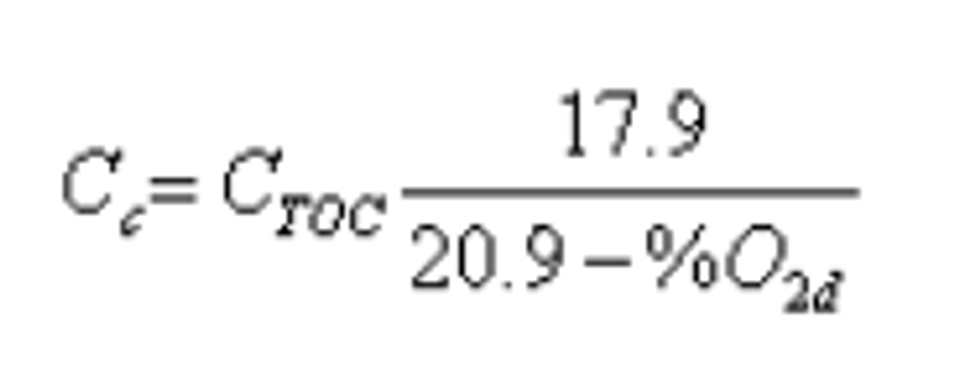
where:
Cc = Concentration of TOC corrected to 3 percent O2, dry basis, ppm by volume.
CTOC = Concentration of TOC (minus methane and ethane), dry basis, ppm by volume.
%O2d = Concentration of O2, dry basis, percent by volume.
(4) Method 18 of appendix A-6 to this part to determine the concentration of TOC in the control device outlet and the concentration of TOC in the inlet when the reduction efficiency of the control device is to be determined. ASTM D6420-18 (incorporated by reference, see §60.17) may be used in lieu of Method 18, if the target compounds are all known and are all listed in Section 1.1 of ASTM D6420-18 as measurable; ASTM D6420-18 may not be used for methane and ethane; and ASTM D6420-18 may not be used as a total VOC method.
(i) The sampling time for each run shall be 1 hour in which either an integrated sample or four grab samples shall be taken. If grab sampling is used then the samples shall be taken at 15-minute intervals.
(ii) The emission reduction (R) of TOC (minus methane and ethane) shall be determined using the following equation:
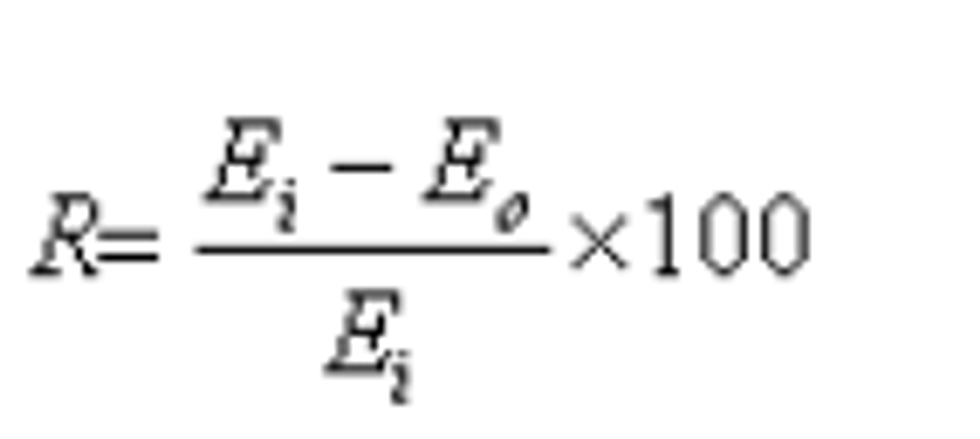
where:
R = Emission reduction, percent by weight.
Ei = Mass rate of TOC entering the control device, kg/hr (lb/hr).
Eo = Mass rate of TOC discharged to the atmosphere, kg/hr (lb/hr).
(iii) The mass rates of TOC (Ei, Eo) shall be computed using the following equations:
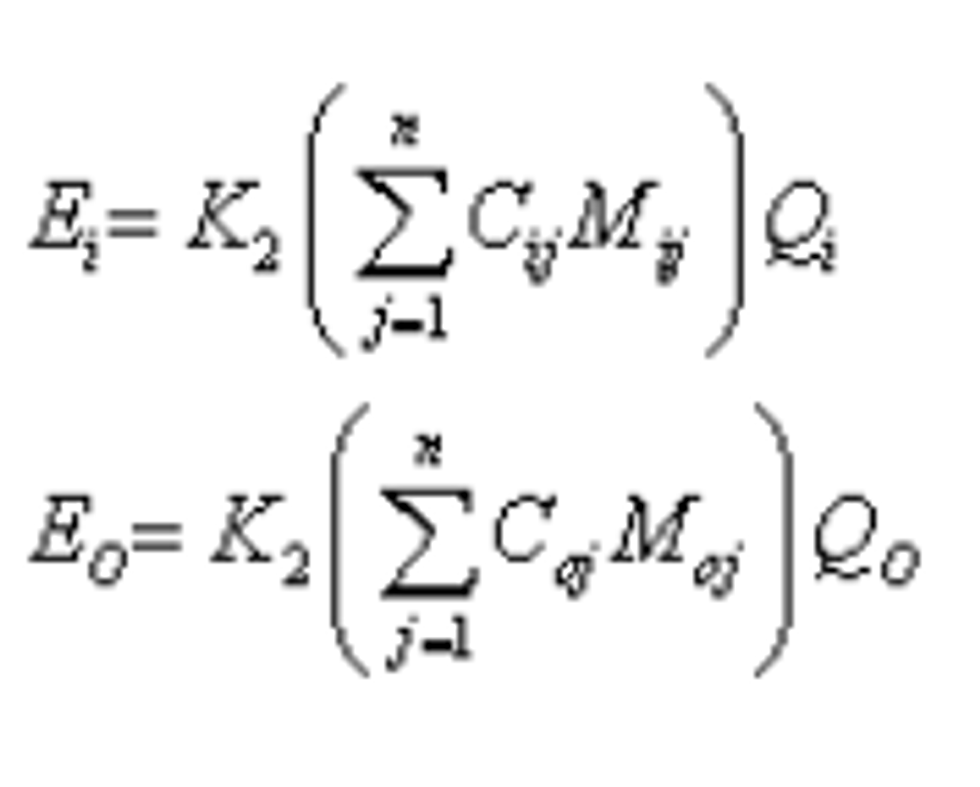
where:
Cij, Coj = Concentration of sample component “j” of the gas stream at the inlet and outlet of the control device, respectively, dry basis, ppm by volume.
Mij, Moj = Molecular weight of sample component “j” of the gas stream at the inlet and outlet of the control device, respectively, g/g-mole (lb/lb-mole).
Qi, Qo = Flow rate of gas stream at the inlet and outlet of the control device, respectively, dscm/min (dscf/min).
K2 = 2.494 × 10−6 (1/ppm)(g-mole/scm) (kg/g) (min/hr) (metric units), where standard temperature for (g-mole/scm) is 20°C.
= 1.557 × 10−7 (1/ppm) (lb-mole/scf) (min/hr) (English units), where standard temperature for (lb-mole/scf) is 68°F.
(iv) The TOC concentration (CTOC) is the sum of the individual components and shall be computed for each run using the following equation:
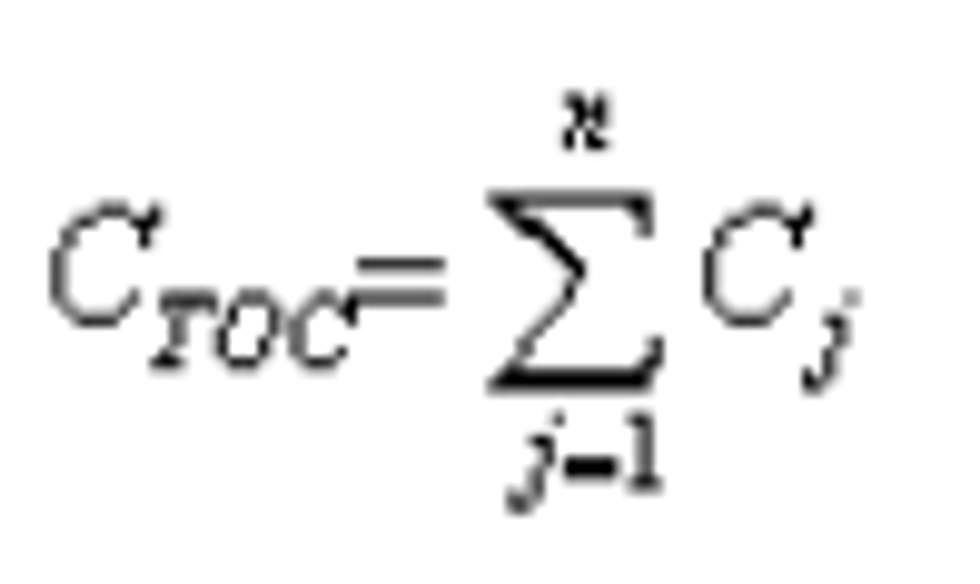
where:
CTOC = Concentration of TOC (minus methane and ethane), dry basis, ppm by volume.
Cj = Concentration of sample components “j”, dry basis, ppm by volume.
n = Number of components in the sample.
(c) When a boiler or process heater with a design heat input capacity of 44 MW (150 million Btu/hour) or greater is used to seek to comply with §60.662(a), the requirement for an initial performance test is waived, in accordance with §60.8(b). However, the Administrator reserves the option to require testing at such other times as may be required, as provided for in section 114 of the Act.
(d) When a flare is used to seek to comply with §60.662(b), the flare shall comply with the requirements of §60.18.
(e) The following test methods, except as provided under §60.8(b), shall be used for determining the net heating value of the gas combusted to determine compliance under §60.662(b) and for determining the process vent stream TRE index value to determine compliance under §60.662(c).
(1)(i) Method 1 or 1A of appendix A-1 to this part, as appropriate, for selection of the sampling site. The sampling site for the vent stream flow rate and molar composition determination prescribed in paragraphs (e)(2) and (3) of this section shall be, except for the situations outlined in paragraph (e)(1)(ii) of this section, prior to the inlet of any control device, prior to any post-distillation dilution of the stream with air, and prior to any post-distillation introduction of halogenated compounds into the process vent stream. No transverse site selection method is needed for vents smaller than 10 centimeters (4 inches) in diameter.
(ii) If any gas stream other than the distillation vent stream from the affected facility is normally conducted through the final recovery device.
(A) The sampling site for vent stream flow rate and molar composition shall be prior to the final recovery device and prior to the point at which the nondistillation stream is introduced.
(B) The efficiency of the final recovery device is determined by measuring the TOC concentration using Method 18 of appendix A-6 to this part, or ASTM D6420-18 (incorporated by reference, see §60.17) as specified in paragraph (b)(4) of this section, at the inlet to the final recovery device after the introduction of any nondistillation vent stream and at the outlet of the final recovery device.
(C) This efficiency is applied to the TOC concentration measured prior to the final recovery device and prior to the introduction of the nondistillation stream to determine the concentration of TOC in the distillation vent stream from the final recovery device. This concentration of TOC is then used to perform the calculations outlined in §60.664(e)(4) and (5).
(2) The molar composition of the process vent stream shall be determined as follows:
(i) Method 18 of appendix A-6 to this part, or ASTM D6420-18 (incorporated by reference, see §60.17) as specified in paragraph (b)(4) of this section, to measure the concentration of TOC including those containing halogens.
(ii) ASTM D1946-77 or 90 (Reapproved 1994) (incorporation by reference as specified in §60.17 of this part) to measure the concentration of carbon monoxide and hydrogen.
(iii) Method 4 of appendix A-3 to this part to measure the content of water vapor.
(3) The volumetric flow rate shall be determined using Method 2, 2A, 2C, or 2D of appendix A-1 to this part, as appropriate.
(4)(i) The net heating value of the vent stream shall be calculated using the following equation:

Where:
H T = Net heating value of the sample, MJ/scm (Btu/scf), where the net enthalpy per mole of vent stream is based on combustion at 25 °C and 760 mm Hg (77 °F and 30 in. Hg), but the standard temperature for determining the volume corresponding to one mole is 20 °C (68 °F).
K 1 = 1.74 × 10 −7 (1/ppm) (g-mole/scm) (MJ/kcal) (metric units), where standard temperature for (g-mole/scm) is 20 °C.
= 1.03 × 10 −11 (1/ppm) (lb-mole/scf) (Btu/kcal) (English units) where standard temperature for (lb/mole/scf) is 68 °F.
C j = Concentration on a wet basis of compound j in ppm, as measured for organics by Method 18 of appendix A-6 to this part, or ASTM D6420-18 (incorporated by reference, see §60.17) as specified in paragraph (b)(4) of this section, and measured for hydrogen and carbon monoxide by ASTM D1946-77 or 90 (Reapproved 1994) (incorporated by reference, see §60.17) as indicated in paragraph (e)(2) of this section.
H j = Net heat of combustion of compound j, kcal/(g-mole) [kcal/(lb-mole)], based on combustion at 25 °C and 760 mm Hg (77 °F and 30 in. Hg).
(ii) The heats of combustion of vent stream components would be required to be determined using ASTM D2382-76 (incorporated by reference as specified in §60.17) if published values are not available or cannot be calculated.
(5) The emission rate of TOC in the vent stream shall be calculated using the following equation:

Where:
E TOC = Measured emission rate of TOC, kg/hr (lb/hr).
K 2 = 2.494 × 10 −6 (1/ppm) (g-mole/scm) (kg/g) (min/hr) (metric units), where standard temperature for (g-mole/scm) is 20 °C.
= 1.557 × 10 −7 (1/ppm) (lb-mole/scf) (min/hr) (English units), where standard temperature for (lb-mole/scf) is 68 °F.
C j = Concentration on a wet basis of compound j in ppm, as measured by Method 18 of appendix A-6 to this part, or ASTM D6420-18 (incorporated by reference, see §60.17) as specified in paragraph (b)(4) of this section, as indicated in paragraph (e)(2) of this section.
M j = Molecular weight of sample j, g/g-mole (lb/lb-mole).
Q s = Vent stream flow rate, scm/min (scf/min), at a temperature of 20 °C (68 °F).
(6) The total process vent stream concentration (by volume) of compounds containing halogens (ppmv, by compound) shall be summed from the individual concentrations of compounds containing halogens which were measured by Method 18 of appendix A-6 to this part, or ASTM D6420-18 (incorporated by reference, see §60.17) as specified in paragraph (b)(4) of this section.
(f) For purposes of complying with §60.662(c) the owner or operator of a facility affected by this subpart shall calculate the TRE index value of the vent stream using the equation for incineration in paragraph (e)(1) of this section for halogenated vent streams. The owner or operator of an affected facility with a nonhalogenated vent stream shall determine the TRE index value by calculating values using both the incinerator equation in (e)(1) and the flare equation in (e)(2) of this section and selecting the lower of the two values.
(1) The equation for calculating the TRE index value of a vent stream controlled by an incinerator is as follows:

(i) Where for a vent stream flow rate that is greater than or equal to 14.2 scm/min (501 scf/min) at a standard temperature of 20°C (68°F):
TRE = TRE index value.
Qs = Vent stream flow rate, scm/min (scf/min), at a temperature of 20°C (68°F).
HT = Vent stream net heating value, MJ/scm (Btu/scf), where the net enthalpy per mole of vent stream is based on combustion at 25°C and 760 mm Hg (68°F and 30 in. Hg), but the standard temperature for determining the volume corresponding to one mole is 20°C (68°F) as in the definition of Qs.
Ys = Qs for all vent stream categories listed in table 1 except for Category E vent streams where Ys = QsHT/3.6.
ETOC = Hourly emissions of TOC, kg/hr (lb/hr).
a, b, c, d, e, and f are coefficients.
The set of coefficients that apply to a vent stream can be obtained from table 1.
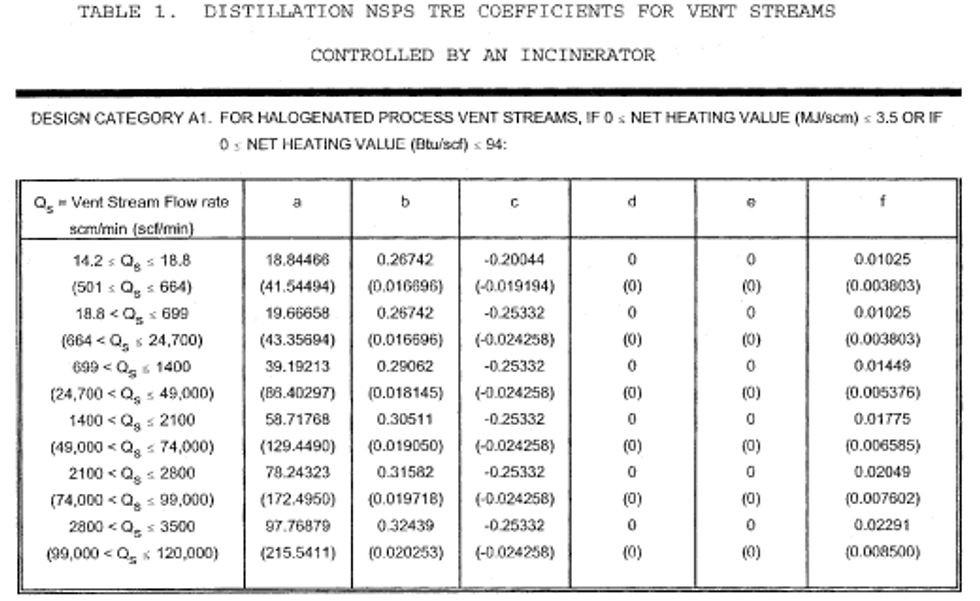
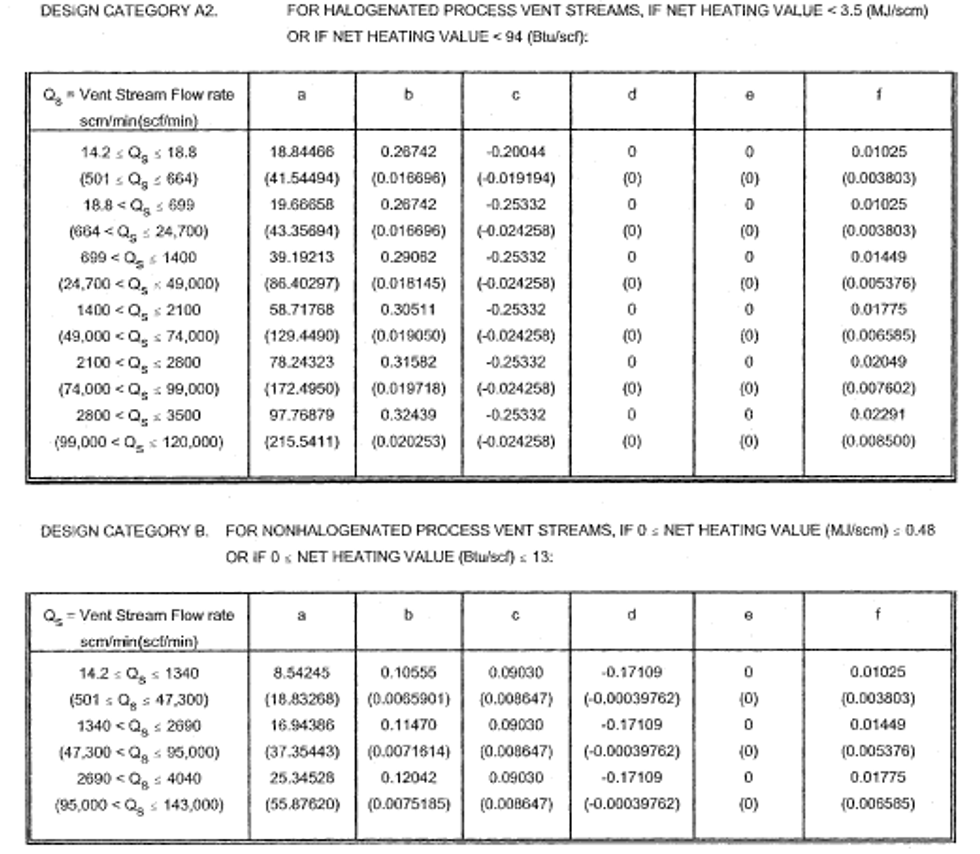
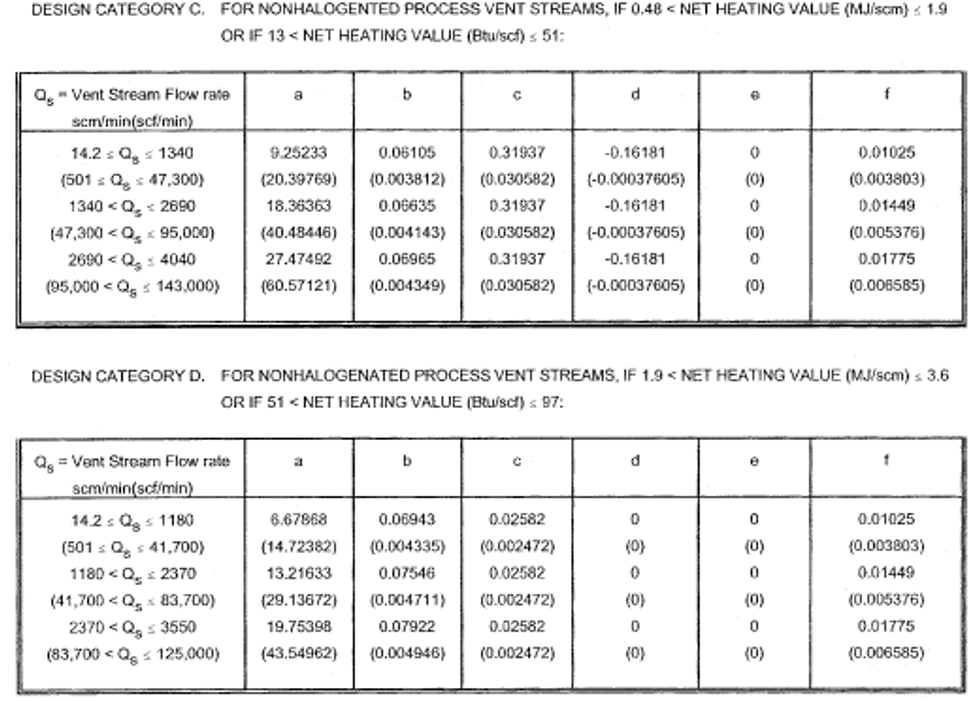
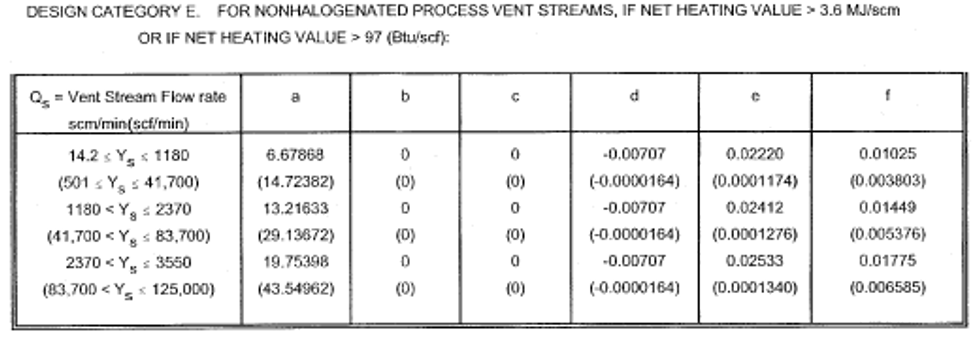
(ii) Where for a vent stream flow rate that is less than 14.2 scm/min (501 scf/min) at a standard temperature of 20°C (68°F):
TRE = TRE index value.
Qs = 14.2 scm/min (501 scf/min).
HT = (FLOW) (HVAL)/Qs.
Where the following inputs are used:
FLOW = Vent stream flow rate, scm/min (scf/min), at a temperature of 20°C (68°F).
HVAL = Vent stream net heating value, MJ/scm (Btu/scf), where the net enthalpy per mole of vent stream is based on combustion at 25°C and 760 mm Hg (68°F and 30 in. Hg), but the standard temperature for determining the volume corresponding to one mole is 20°C (68°F) as in the definition of Qs.
Ys = Qs for all vent stream categories listed in table 1 except for Category E vent streams where Ys = QsHT/3.6.
ETOC = Hourly emissions of TOC, kg/hr (lb/hr).
a, b, c, d, e, and f are coefficients
The set of coefficients that apply to a vent stream can be obtained from table 1.
(2) The equation for calculating the TRE index value of a vent stream controlled by a flare is as follows:

where:
TRE = TRE index value.
ETOC = Hourly emissions of TOC, kg/hr (lb/hr).
Qs = Vent stream flow rate, scm/min (scf/min), at a standard temperature of 20°C (68°F).
HT = Vent stream net heating value, MJ/scm (Btu/scf), where the net enthalpy per mole of vent stream is based on combustion at 25°C and 760 mm Hg (68°F and 30 in. Hg), but the standard temperature for determining the volume corresponding to one mole is 20°C (68°F) as in the definition of Qs.
a, b, c, d, and e are coefficients.
The set of coefficients that apply to a vent stream shall be obtained from table 2.
| a | b | c | d | e | |
|---|---|---|---|---|---|
| HT < 11.2 MJ/scm | 2.25 | 0.288 | −0.193 | −0.0051 | 2.08 |
| (HT < 301 Btu/scf) | (0.140) | (0.0367) | (−0.000448) | (−0.0051) | (4.59) |
| HT ≥ 11.2 MJ/scm | 0.309 | 0.0619 | −0.0043 | −0.0034 | 2.08 |
| (HT ≥ 301 Btu/scf) | (0.0193) | (0.00788) | (−0.0000010) | (−0.0034) | (4.59) |
(g) Each owner or operator of an affected facility seeking to comply with §60.660(c)(4) or §60.662(c) shall recalculate the TRE index value for that affected facility whenever process changes are made. Examples of process changes include changes in production capacity, feedstock type, or catalyst type, or whenever there is replacement, removal, or addition of recovery equipment. The TRE index value shall be recalculated based on test data, or on best engineering estimates of the effects of the change to the recovery system.
(1) Where the recalculated TRE index value is less than or equal to 1.0, the owner or operator shall notify the Administrator within 1 week of the recalculation and shall conduct a performance test according to the methods and procedures required by §60.664 in order to determine compliance with §60.662(a). Performance tests must be conducted as soon as possible after the process change but no later than 180 days from the time of the process change.
(2) Where the initial TRE index value is greater than 8.0 and the recalculated TRE index value is less than or equal to 8.0 but greater than 1.0, the owner or operator shall conduct a performance test in accordance with §§60.8 and 60.664 and shall comply with §§60.663, 60.664 and 60.665. Performance tests must be conducted as soon as possible after the process change but no later than 180 days from the time of the process change.
(h) Any owner or operator subject to the provisions of this subpart seeking to demonstrate compliance with §60.660(c)(6) shall use Method 2, 2A, 2C, or 2D as appropriate, for determination of volumetric flow rate.
[55 FR 26942, June 29, 1990, as amended at 65 FR 61774, Oct. 17, 2000; 89 FR 43067, May 16, 2024]
['Air Programs']
['Air Quality']
UPGRADE TO CONTINUE READING
Load More
J. J. Keller is the trusted source for DOT / Transportation, OSHA / Workplace Safety, Human Resources, Construction Safety and Hazmat / Hazardous Materials regulation compliance products and services. J. J. Keller helps you increase safety awareness, reduce risk, follow best practices, improve safety training, and stay current with changing regulations.
Copyright 2025 J. J. Keller & Associate, Inc. For re-use options please contact copyright@jjkeller.com or call 800-558-5011.
